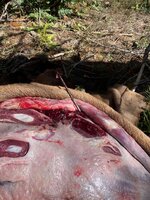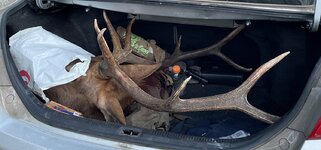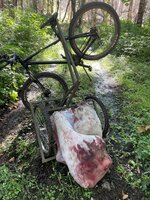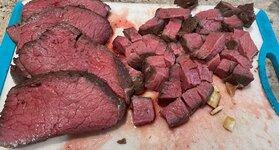I made a post before the season of my elk goals:
I spent the pre-season perfecting the sequences shared in @ElkNut1 ’s app and I went into opening weekend more confident than ever. First week of the season, I called in a black bear that came into my sequence just minutes after I ended it. The boar was probably going 4+mph and came right by me without noticing my presence and looked entirely focused on trying to catch up to the supposed herd of cows and calves. Bears account for more elk calf mortality than many realize. I had a bear tag and my arrow was nocked. I chirped and the bear came to a full stop below me. I was at full draw but the shooting lane was not clear and the bear soon caught my wind only to leave as fast as it came in.
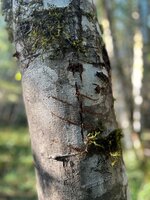
Although I was diligent about not leaving my elk set-ups too soon, I would come back to my sequence spot a day or two later only to find a tree completely thrashed or the ground pawed and raked out. I presume a bull heard me from his bed and eventually made his way to the spot after my departure.
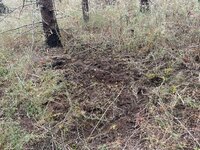
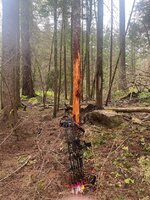
I love hunting but my family comes first and sometimes I only get to hunt a morning or an evening. Each hour in the woods is a gift and it doesn’t take long to find a rhythm in the woods that cannot be duplicated anywhere else. Your mind and body crave the crisp mornings and the smells of the mountain that cannot be found in the daily grind of civilization.
On Sep. 3rd, I did an advertising bugle from a ridge in thick timber and got a lazy bugle back in response. It was 12:30PM. The bull bugled from his bed. It was the first and only bugle I heard of the season. But I knew I only needed to hear one bugle. As my eyes scanned the bedding area, my brain whispered, “You’re dead!”. I knew I could kill this bull if I did everything right.
I dropped 500’ below to get on the bull’s contour and I proceed to advertise myself by raking, pawing the ground, grunting, panting, and sounding like a bull feeling his oats in the early season. Much of my sounds were my own voice through a tube. I knew I had the bull’s attention. In my head were the voices of all the online mentors that I’ve embraced over the last several years – ElkNut, Jason Phelps, Dirk Durham, Corey Jacobson, Born & Raised, Elk Shape, Angry Spike, ElkBro’s, Chris Roe, Joel Turner, Mark Livesay, and many others. Each of them was in my mind providing tips. As a solo hunter, these guys kind of become your invisible partners!
Chris Roe and others speak about the “Doorway Principle” – the place where bulls get hung up because they want to verify with their eyes what they heard. Although I was on contour with the bull, I didn’t like the openness of the terrain and the thermals were not consistent because of the shade in the bottom. The wind was swirly. I knew I had to get out of this area and steer the bull away from my set-up so that he would not pick up any scent that I left at this spot.
I quickly climbed out of the hole, 500’ back up to thick timber with consistent thermals and cover. I reached the ridge and let out a single bugle to let the bull know of my new position and to steer him back toward me. The thermals were going consistently up and I was certain to not silhouette myself in the sun. I skirted around the ridge and saw horns just before hearing the bull take off. I was perplexed - thermals and concealment were good. I quickly realized that the horns I saw were of a smaller bull who had been ran off by the larger bull that bugled from his bed. The bigger bull was coming. I continued around the ridge and found an ideal set-up spot. I could use the thick timber behind me and a knoll on a knife ridge to bring the bull to me. I ranged a tree at the Doorway – the exact spot I knew the bull should stop. I cleared all the debris around my feet and made sure I could move left and right without being detected. I saw the bull’s tines coming up the knife ridge below the knoll. I drew back. The bull came to the doorway and stopped – exactly in front of the tree I ranged only 1 minute earlier. He started scanning back and forth with his head. He was in search mode. I was silent. I said nothing.
During my 2021 season, there were times where I became caught up in the excitement of the elk talk. A bugling elk is a big reason people archery hunt. There were times in the past where I gave away my position by calling at the wrong time and losing the element of surprise – which is critical when solo hunting. As a solo hunter, staking out a set-up spot is arguably the most important thing I do. Nearly all of my memorable mistakes, where I should have killed an elk but didn’t, revolved around a bad set-up. My hard lessons from year’s past were going to pay off. A diaphragm was in my mouth, but there was no need to call at this point. The bull would have to spend time finding me in the thick timber.
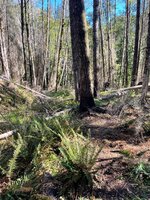
At full draw, I went through my mental shot sequence and sent the sharpest broadhead I’ve ever held. The Ranch Fairy has some pretty crazy ideas that don’t always align with my western big game style, but earlier this Spring I watched several YouTube videos where he explained how to sharpen broadheads. My broadheads, which are not expensive or fancy, will pop a single hair off your arm and flick it across the room. That’s scary sharp! I use a jig and various sandpapers. The time-consuming but satisfying process is completed with metal buffing compound and a leather strop. You can literally see your image in the edge of the broadhead. It is a mirror finish. I shoot an older bow with a 26” DL, 72lbs, and a 442 grain arrow at 252 FPS. Those are not impressive bow specs but a sharp fixed blade broadhead out of a well-tuned bow cannot be understated.
After going through my shot sequence, I watched my arrow completely disappear. There was no thunk, thud, or pop, like I experienced in the past. The arrow was just gone. The bull whirled and as I bugled and let out two cow calls, I heard a terrible crash. He was dead in less than 7 seconds, and I was standing over my first decent Roosevelt at 1pm. When solo, there is no real celebration. The pressure of filling your tag is gone, but it’s quickly replaced by the work that lies ahead. By 5:30pm I had him quartered, bagged, and shuttled to the top of the ridge. The area is full of predators. After following the gutless process, I opened up the elk’s cavity and pushed out the guts. I wanted the heart, but I equally wanted any predators to prioritize the carcass and not my meat bags.
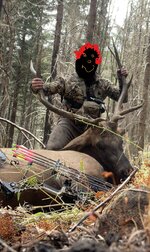
- Kill another bull solo.
- Improve on my calling and spot and stalk technique
- Improve upon my mountain skills.
- Avoid bee’s nests
- Have Fun.
I spent the pre-season perfecting the sequences shared in @ElkNut1 ’s app and I went into opening weekend more confident than ever. First week of the season, I called in a black bear that came into my sequence just minutes after I ended it. The boar was probably going 4+mph and came right by me without noticing my presence and looked entirely focused on trying to catch up to the supposed herd of cows and calves. Bears account for more elk calf mortality than many realize. I had a bear tag and my arrow was nocked. I chirped and the bear came to a full stop below me. I was at full draw but the shooting lane was not clear and the bear soon caught my wind only to leave as fast as it came in.

Although I was diligent about not leaving my elk set-ups too soon, I would come back to my sequence spot a day or two later only to find a tree completely thrashed or the ground pawed and raked out. I presume a bull heard me from his bed and eventually made his way to the spot after my departure.


I love hunting but my family comes first and sometimes I only get to hunt a morning or an evening. Each hour in the woods is a gift and it doesn’t take long to find a rhythm in the woods that cannot be duplicated anywhere else. Your mind and body crave the crisp mornings and the smells of the mountain that cannot be found in the daily grind of civilization.
On Sep. 3rd, I did an advertising bugle from a ridge in thick timber and got a lazy bugle back in response. It was 12:30PM. The bull bugled from his bed. It was the first and only bugle I heard of the season. But I knew I only needed to hear one bugle. As my eyes scanned the bedding area, my brain whispered, “You’re dead!”. I knew I could kill this bull if I did everything right.
I dropped 500’ below to get on the bull’s contour and I proceed to advertise myself by raking, pawing the ground, grunting, panting, and sounding like a bull feeling his oats in the early season. Much of my sounds were my own voice through a tube. I knew I had the bull’s attention. In my head were the voices of all the online mentors that I’ve embraced over the last several years – ElkNut, Jason Phelps, Dirk Durham, Corey Jacobson, Born & Raised, Elk Shape, Angry Spike, ElkBro’s, Chris Roe, Joel Turner, Mark Livesay, and many others. Each of them was in my mind providing tips. As a solo hunter, these guys kind of become your invisible partners!
Chris Roe and others speak about the “Doorway Principle” – the place where bulls get hung up because they want to verify with their eyes what they heard. Although I was on contour with the bull, I didn’t like the openness of the terrain and the thermals were not consistent because of the shade in the bottom. The wind was swirly. I knew I had to get out of this area and steer the bull away from my set-up so that he would not pick up any scent that I left at this spot.
I quickly climbed out of the hole, 500’ back up to thick timber with consistent thermals and cover. I reached the ridge and let out a single bugle to let the bull know of my new position and to steer him back toward me. The thermals were going consistently up and I was certain to not silhouette myself in the sun. I skirted around the ridge and saw horns just before hearing the bull take off. I was perplexed - thermals and concealment were good. I quickly realized that the horns I saw were of a smaller bull who had been ran off by the larger bull that bugled from his bed. The bigger bull was coming. I continued around the ridge and found an ideal set-up spot. I could use the thick timber behind me and a knoll on a knife ridge to bring the bull to me. I ranged a tree at the Doorway – the exact spot I knew the bull should stop. I cleared all the debris around my feet and made sure I could move left and right without being detected. I saw the bull’s tines coming up the knife ridge below the knoll. I drew back. The bull came to the doorway and stopped – exactly in front of the tree I ranged only 1 minute earlier. He started scanning back and forth with his head. He was in search mode. I was silent. I said nothing.
During my 2021 season, there were times where I became caught up in the excitement of the elk talk. A bugling elk is a big reason people archery hunt. There were times in the past where I gave away my position by calling at the wrong time and losing the element of surprise – which is critical when solo hunting. As a solo hunter, staking out a set-up spot is arguably the most important thing I do. Nearly all of my memorable mistakes, where I should have killed an elk but didn’t, revolved around a bad set-up. My hard lessons from year’s past were going to pay off. A diaphragm was in my mouth, but there was no need to call at this point. The bull would have to spend time finding me in the thick timber.

At full draw, I went through my mental shot sequence and sent the sharpest broadhead I’ve ever held. The Ranch Fairy has some pretty crazy ideas that don’t always align with my western big game style, but earlier this Spring I watched several YouTube videos where he explained how to sharpen broadheads. My broadheads, which are not expensive or fancy, will pop a single hair off your arm and flick it across the room. That’s scary sharp! I use a jig and various sandpapers. The time-consuming but satisfying process is completed with metal buffing compound and a leather strop. You can literally see your image in the edge of the broadhead. It is a mirror finish. I shoot an older bow with a 26” DL, 72lbs, and a 442 grain arrow at 252 FPS. Those are not impressive bow specs but a sharp fixed blade broadhead out of a well-tuned bow cannot be understated.
After going through my shot sequence, I watched my arrow completely disappear. There was no thunk, thud, or pop, like I experienced in the past. The arrow was just gone. The bull whirled and as I bugled and let out two cow calls, I heard a terrible crash. He was dead in less than 7 seconds, and I was standing over my first decent Roosevelt at 1pm. When solo, there is no real celebration. The pressure of filling your tag is gone, but it’s quickly replaced by the work that lies ahead. By 5:30pm I had him quartered, bagged, and shuttled to the top of the ridge. The area is full of predators. After following the gutless process, I opened up the elk’s cavity and pushed out the guts. I wanted the heart, but I equally wanted any predators to prioritize the carcass and not my meat bags.

Last edited:

